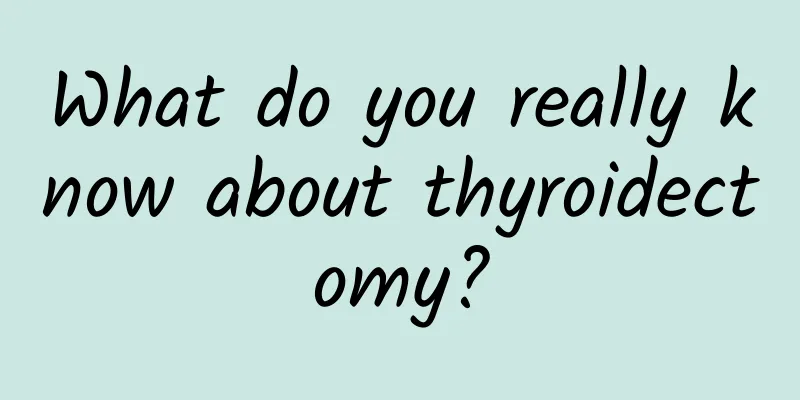What do you really know about thyroidectomy?

|
Thyroid disease is a common endocrine disease in clinical practice, and thyroidectomy is a common treatment method. However, many patients do not have enough information or even misunderstandings when facing thyroid surgery. Scientific health education and psychological guidance can help patients accurately understand thyroid surgery, reduce their fear and resistance to surgery, and improve treatment compliance. The conclusions of this study can help medical staff prepare for thyroidectomy and conduct postoperative rehabilitation management, providing theoretical support and practical reference, in order to improve the effect of thyroid disease treatment and the quality of life of patients. 1. Overview of thyroid disease The thyroid gland, located in the front of the human neck, is shaped like a butterfly. Its main function is to secrete three important hormones, namely thyroxine, triiodothyronine and calmodulin, which play a key role in the body's basic metabolism, growth and development, and nervous system. There are many types of thyroid diseases, including benign diseases such as thyroid nodules, goiter (hyperthyroidism and hypothyroidism), thyroiditis, etc.; malignant diseases such as thyroid cancer. The causes of these diseases are diverse and may be related to genetics, environmental factors, immune function, eating habits, and even stress. Clinically, common symptoms of thyroid disease include neck swelling, throat discomfort, hoarseness, hand tremors, palpitations, irritability, and even depression. Methods for diagnosing thyroid disease generally include blood tests, imaging tests, biopsies, etc. It is worth noting that the incidence of thyroid disease in women is higher than that in men. Data from the World Association for the Study of Thyroid show that the incidence of thyroid disease in women is 5 to 10 times higher than that in men. With the advancement of science and technology and the acceleration of globalization, human understanding of thyroid diseases is deepening, and its treatment methods are becoming increasingly diverse, and thyroidectomy is an important part of it. 2. Necessity and indications for thyroidectomy Thyroidectomy is an important means of treating thyroid diseases. It is suitable for thyroid tumors, thyroiditis, hyperthyroidism, etc. The necessity of surgery lies in the inability to treat the condition through non-surgical methods such as drugs, and the indication lies in the clearer treatment effect or ineffectiveness of other methods. Although surgery has risks, it is sometimes the most effective treatment method. 3. Introduction to thyroidectomy surgery Thyroidectomy is a common surgical procedure for treating thyroid diseases in the medical field, which mainly includes total thyroidectomy and subtotal thyroidectomy. Total thyroidectomy means that the patient's entire thyroid gland is removed. Subtotal thyroidectomy only removes part of the thyroid gland, mainly for patients with some benign thyroid diseases. Whether it is a total or partial resection, the main steps include: determining the location and extent of the lesion before the first operation, choosing the appropriate surgical method, and under general anesthesia, the doctor cuts the skin along the natural wrinkles of the neck, removes the diseased thyroid gland, and removes nearby lymph nodes if necessary. During the operation, special attention is paid to protecting the surrounding important structures, such as the recurrent laryngeal nerve and parathyroid glands. After surgery, patients need to receive hormone replacement therapy to maintain normal body functions. Although surgery is less invasive and recovery is quick, any surgery has risks, including bleeding, infection, voice changes, etc., and the patient's condition needs to be closely monitored after surgery. Surgery is not the only treatment for thyroid disease. Patients can choose the best treatment plan according to their own conditions under the guidance of a doctor. 4. Analysis of complications of thyroidectomy Although thyroidectomy is considered a relatively safe surgery in the medical community, it does not mean that there are no risks. Postoperative complications include common clinical complications such as postoperative bleeding and infection, as well as complications specific to thyroid surgery, such as vocal cord paralysis and hypocalcemia. The thyroid gland is located in the larynx, close to the vocal nerve. If the surrounding tissues are improperly manipulated during surgery, it is likely to cause damage to the vocal nerve, which in turn causes hoarseness, rough voice, etc. Although vocal nerve damage is temporary in most cases, there are a few cases where it cannot be recovered, which depends on the individual situation and the degree of damage. Another complication that needs attention is hypocalcemia. There are four parathyroid glands around the thyroid gland. These four tiny glands are responsible for regulating the calcium content in the human blood. If the parathyroid glands are damaged or accidentally removed during surgery, it may cause low blood calcium. The patient may experience symptoms such as numbness in the hands and feet and muscle cramps. Of course, despite these complications, experienced doctors will take various measures to reduce the risk, such as fine decomposition, good surgical field guarantee, etc. Every operation requires the patient to fully understand the recovery process, possible risks and complications, and reasonably adjust the postoperative life to ensure the best recovery effect. Conclusion Thyroid surgery is an important method for treating thyroid diseases. It is necessary to understand the necessity, methods and complications of surgery. Knowing these can help doctors and patients better understand and deal with related issues. Through continuous learning and exploration, medical services and the quality of life of patients can be improved. Author: Wang Zehua Shunping County Hospital |
<<: Anesthesia and surgical risks: How to reduce surgical risks and complications?
>>: What is bone hyperplasia? Can you still do these things after bone hyperplasia?
Recommend
What is the fastest way to lose breast fat?
A woman's breasts are an important symbol of ...
What causes vaginal bleeding in women?
Vaginal bleeding will cause serious harm to the b...
In response to the cross-provincial transmission chain of Omicron, here are the 6 questions you care about!
At the end of the year and the beginning of the n...
What is the best way to treat double uterus?
If a woman is found to have a double uterus durin...
Talk about delayed menstruation after ovulation bleeding
Ovulation bleeding is a problem that many women h...
Clear fluid during ovulation
In a month, a woman's body is divided into th...
How to stop bleeding when menstruation has not come?
Girls have their menstrual period every month, an...
When is the beginning of winter in 2021? What does it mean to have a clear winter day?
The Beginning of Winter is the first festival of ...
What is the reason for a long menstrual period?
Every woman has her menstrual period every month,...
Pictures of normal areola with pimples
Many female friends think that nipples should be ...
How to treat luteal follicle cyst
Once a patient has an ovarian corpus luteum cyst ...
How to restore your figure after childbirth
In fact, in daily life, if many women's figur...
Can I eat crayfish if I have breast hyperplasia?
Breast hyperplasia is a disease that is neither b...
When is the ovulation period when the menstruation comes on the 22nd?
When calculating your ovulation period, you shoul...









